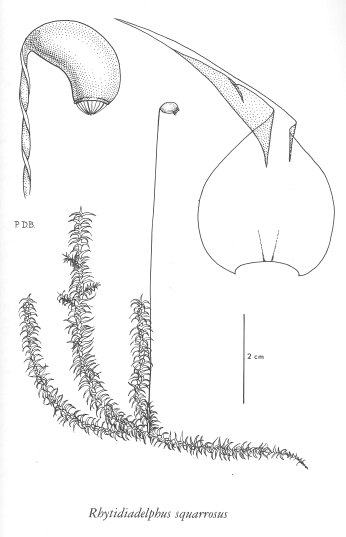Rhytidiadelphus squarrosus (Hedw.) Warnst.
bent-leaf moss (square goose neck moss)
Hylocomiaceae
Species Account Author: Wilf Schofield
Extracted from Some Common Mosses of BC
Introduction to the Bryophytes of BC
bent-leaf moss (square goose neck moss)
Hylocomiaceae
Species Account Author: Wilf Schofield
Extracted from Some Common Mosses of BC
Introduction to the Bryophytes of BC
Map
Distribution of Rhytidiadelphus squarrosus
Click here to view the full interactive map and legend
Species Information
Species description:
Species name referring to the leaf form where the upper portion bends outward and downward at right angles to the body of the leaf.
Comments:
This is one of the most frequent lawn pests in cities and towns near the coast; its growth is enhanced through late-season lawn mowing and fertilization, since it grows during the wet winter when the grass is dormant.
Distinguishing characteristics:
The strongly and regularly squarrose leaves of the frequently erect main stems serve as useful characters. In open sites, branching is very irregular. Often plants in lawns or on stabilized dunes form turf-like carpets of erect plants.
Habit:
Forming loose mats of suberect shoots with strongly squarrose leaves, giving the shoot apex a star-like appearance when viewed from above; light green in colour with a tinge of red brown, especially in open areas.
Similar Species:
R. squarrosus is occasionally difficult to separate from R. loreus. R. squarrosus, however, regularly has squarrose leaves on the main stem and pleats are lacking or obscure in the leaves. R. squarrosus never possesses falcate-secund leaves at the main stem apex and is usually in open sites.
Illustration

If more than one illustration is available for a species (e.g., separate illustrations were provided for two subspecies) then links to the separate images will be provided below. Note that individual subspecies or varietal illustrations are not always available.
Illustration Source: Some Common Mosses of BC
Habitat and Range
Habitat
A common "weed" in lawns, especially in areas where moisture persists in shade, also on stabilized sand near the sea, and among grasses. Along streams, plants and shoots are arched and reclining and frequently regularly branched. This variant is often treated as a separate species, R. subpinnatus; plants of sub alpine and alpine elevations are in seepage sites and tend to be irregularly branched. Range
World DistributionCircumpolar in the Northern Hemisphere; in North America predominantly near the coasts and in mountains, in the east from Newfoundland southward to the northern Appalachian Mountains; in the west from Alaska southward to California and inland to western Montana
Status Information
Synonyms
Synonyms and Alternate Names:
Rhytidiadelphus calvescens (Kindb.) Broth.
Rhytidiadelphus squarrosus var. calvescens (Kindb.) Warnst.